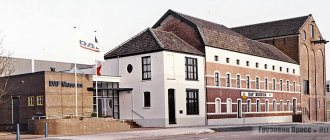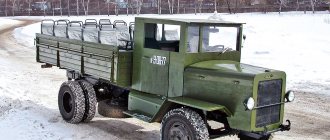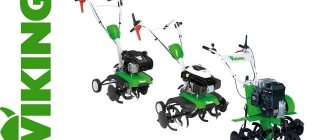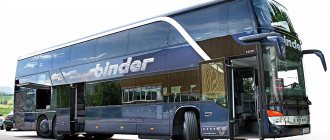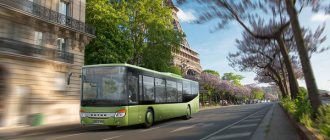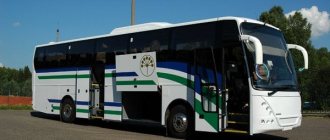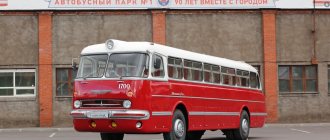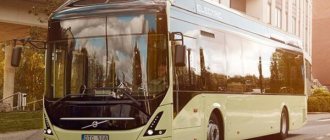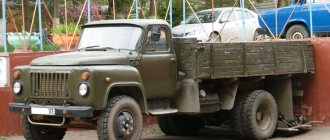Bus Setra S431DT. Photo Wikipedia
Companies from Germany offer a range of vehicles that have numerous advantages. First of all, this applies to passenger cars. But German enterprises also produce a wide range of buses, characterized by an equally extensive list of advantages. Among the companies, Neoplan, MAN, Mercedes, and also Setra stand out especially, whose popular models are the focus of this review.
About the manufacturer
Setra Omnibusse is one of the large German bus manufacturers from the city of Ulm . It produces Setra brand commercial buses and bodies for tourist buses. The company was founded in 1911 under the name Karl Kassbohrer Fahrzeugwerke GmBH. Since 1994, it has been part of the bus department of Evobus GmbH , which, in turn, is part of the Daimler AG concern.
Setra S8 bus. Photo Wikipedia
Since 1994, a corporate logo in the form of a stylized letter “K” , denoting the name of the company’s founder, Karl Kassbohrer. Perhaps, looking at a competitive market, the German company took care of foreign buyers because the name "Kassbohrer" was difficult to pronounce.
In the European ranking of bus manufacturers, Setra is the most respected in the prestigious premium .
Competing companies
Setra's competitors include primarily other leading German companies. Major market players are Neoplan, known for a large number of non-standard solutions and models in its range, Mercedes and MAN, which, despite having a common organizational structure with Setra, is often considered separately.
In addition, it is possible to note other leading enterprises in the industry:
- Van Hool and Jonckheere (Belgium);
- Volvo (Sweden);
- Dennis Specialist Vehicles and its successor Alexander Dennis (England and Scotland respectively).
It is also possible to list some European and Asian countries in which world-famous enterprises operate: Poland, France, Holland, Spain, Ukraine, Italy, Hungary and China, South Korea, Turkey. Don't forget about American manufacturers.
Model range: Comfort Class and more
Since 1951, the company has been producing buses, starting with the revolutionary S8 model with the world's first monocoque body with a welded space frame made of steel profiles, designed by engineer Otto Kassbohrer. This design is the basis for most modern buses.
In 1967, Setra introduced a series of buses that marked an important step in the development of the brand. The S100 family brought together the best technical innovations of the time. In 1973, the tallest model, the S200 Super-Setra, was released, guaranteeing excellent visibility for tourists. The company produced the first double-decker bus S228DT in 1982.
New standards of design and comfort were set by the 300 series of Setra buses, introduced to the world in 1991.
In 2001, Setra began production of a new family of buses, the Topclass 400. Compared to its predecessor, the model featured a modern design with improved aerodynamics and a lightweight body.
Setra MultiClass buses: S 415 LE business and S 418 LE business. Setra Photos
In 2012, the German company begins production of the 500th series of Setra buses. The firstborn of the family was the Setra Comfort Class 500. Two years later, the luxury touring model Top Class 500 was introduced.
The modern line of models includes three basic families of buses:
- Multi Class - cost-effective and comfortable models with a low floor position;
- Comfort Class – cars for comfortable trips with a lot of luggage;
- tourist maximum comfortable Top Class 500 class.
But Internet users are interested not only in the latest developments of the enterprise, but also in individual models of past years, which are discussed below.
Tall Brothers
For Kässbohrer Fahrzeugwerke, the production of double-decker buses was not a priority. Moreover, she started releasing them quite late. The company made its first experience in 1979, releasing the Setra SG 221 HDS articulated tourist prototype. In fact, it was a high-deck liner, but with one important feature: the driver’s and tour guide’s cabin was located under the top floor. The car was used for advertising and entertainment needs, but two years later the production version of the Setra S 228 DT was presented using the same design (underfloor cabin). The first full-fledged two-story S 216 HDS began to be produced in 1988, and 4 years later it was accompanied by the S 328 DT model. The S 300 generation set the first record for a double-decker tourer in the series: 10 years unchanged. The second record belongs to the S 431 DT, which debuted in 2002 and was discontinued only this year. In total, by 2014, 2,500 Setra double-decker airliners had been produced.
Setra 317 HDH
A tourist one-and-a-half-decker three-axle bus with a capacity of 54 passengers, who have the opportunity to sit on comfortable soft chairs with armrests, headrests, seat belts, two handrails, a net for personal belongings and a small folding table.
Characteristics
- Body dimensions, mm. 13500x2500x-.
- Width between seats, mm. 830.
- Engine. Mercedes-Benz 442 hp, v8, turbodiesel.
- Checkpoint. Automatic 8-speed.
Equipment
- Air conditioning (climate control)
- TV
- DVD/CD
- WiFi
- Microphone
- Fridge
- Kitchenette
- Toilet
- Double glazing
German buses
Enterprises from Europe produce a full range of passenger transport. Companies from individual states require more careful consideration. Such countries include Germany, where a fairly large number of companies operate successfully. Their successful work, innovative developments, high creative and production potential allow us to produce a wide selection of buses with numerous advantages. Advantages and disadvantages Analysis of the activities of manufacturers and the equipment they produce allowed...
- Further -
ANKAI, HIGER, HYUNDAI, IKARUS, IRIZAR, IVECO, KIA, NEOPLAN, OTOKAR, SCANIA, SETRA, TEMSA, YUTONG, Buses, All-terrain buses, Small class buses, AZ URAL, BAZ, Cabover buses, BOGDAN, Large buses, Rotational, VOLZHANIN, High-floor buses, GAZ, GOLAZ, City buses, Utility buses, Double-decker buses, Rear-engine, ZIL, KAVZ, Hood buses, LAZ, LIAZ, MAZ, Brands and models of tourist buses, Intercity buses, NEMAN, NEFAZ, Low-floor buses, Single buses, Extra-large buses, Extra-small buses, PAZ, Front-engine buses, Platform buses, One-and-a-half-decker buses, Suburban buses, Ritual buses, Articulated buses, Sleeper buses, Special buses, Medium buses, ST NIZHEGORODETS, Tourist buses, UAZ, Central-engine, Excursion buses
Double-decker Setra S328DT
Double decker tourist bus.
Setra S328DT double decker bus. Photo Wikipedia
Characteristics
- Years of issue. 1992-2002.
- dimensions , mm. (LxWxH). 12000x2500x4000.
- Number and type of doors. Two single-leaf sliding automatic ones.
- Total number of seats, including landing seats. 74/75, including landing 74/75.
- Distance between seats, mm. 740.
- Type of seats. Separate soft ones with seat belts, armrests, headrests.
- Engine. Mercedes-Benz OM402 LA.
- Type. Diesel.
- Number and arrangement of cylinders. 8V.
- Power, kW (hp)/min. 382 (520).
- Checkpoint. ZF 8-speed manual.
- Brake system. Pneumatic.
Equipment
ABS, ASR, air conditioning, Webasto, double tinted thermal windows, velor folding-retractable seats, newspaper nets, additional heating, interior airflow and ventilation, body lifting and lowering, electrically heated exterior mirrors, 5 TV+DVD+video system, kitchen, toilet , sleeping place for the driver, washbasin, navigation, nets on the seats, shelves in the cabin, refrigerator, boiler, radio, microphone, tables, reading lights, curtains, fuel tank 450+230 l., large trunks.
Specifications
Studying the technical characteristics of buses facilitates the process of choosing the right model for a specific buyer, i.e. machines with optimal characteristics. Therefore, a separate article presents the types of Setra equipment in accordance with external (body dimensions, interior capacity, color schemes, etc.) and internal (type, model, engine characteristics, gearbox, and more) parameters. Familiarization with the information will allow you to understand how wide a list of buses the company offers, structure the information, make a choice and buy a bus.
Bus Setra S517HDH. Setra Photos
Setra S140ES
Setra S140ES (1974 – 1984) - a representative of the 100th class, a modification for suburban/intercity routes, which was first presented at IAA'73, mass production began in 1974.
The company developed the S140ES in 1973. The chassis and engine design was taken from the S140E, the design is based on the S130S. An articulated bus variant based on the S140ES was designated SG 180, which, like the single vehicle, was offered with a variety of door options for urban and intercity traffic.
Bus Setra S140ES. Photo Wikipedia
The first versions were equipped with a diesel engine with a volume of 11.94 liters. from Henschel. From 1975, Daimler-Benz or MAN diesel engines were installed (both 210 hp, later 240 hp), since engine production at Henschel ceased.
As standard, the bus was equipped with a ZF S6-90 gearbox; Voith and Daimler-Benz gearboxes were also available. In 1978, the bus underwent a redesign; in addition, the number of steps at the entrance to the salon increased from three to four, but the height of the steps was reduced to 200 mm.
Body dimensions – 11780x2500x3040.
Number of seats – 53.
Everyday life
Two facts indicate how complex and unique this product is: in total, only 30 companies produce them (fewer than electric buses), and the total fleet of double-decker airliners is estimated at around 50 thousand units. The number of manufacturers has not changed for 50 years. China has taken the place of outgoing producers from the UK and African countries. In the socialist camp, only Hungary and the GDR produced double-decker cars.
Most double-decker buses are used on urban routes. The largest increase in double deckers occurred in the excursion and recreational transportation segment.
In different countries, there are legal restrictions on the release of double-decker buses on the line: a ban on transporting children on the second floor, operation at night, or operation on regular intercity routes. This was the case, for example, in Europe, where until 2013, double-deckers were not issued for intercity travel at all - only for tourist one-day trips. In the secondary market, double-decker buses are not a highly liquid product. Operators are more willing to take lighter, high-floor buses, since there are more than enough offers. They are pushed to this by the specifics of the roads and axial restrictions, because such buses weigh 18 tons in their lightest form, and the weight of tourist liners with a 6x2 wheel arrangement reaches 28 tons! In addition, there are under-bridge and tunnel dimensions, which are found not only in the historical buildings of cities and transit settlements, but also on highways.
Setra S431DT
The pinnacle of the TopClass 400, the descendant of the double-decker Setra S 328 DT, began to shine in all its colors in the fall of 2002.
Description and device
S431DT is the flagship bus of the entire EvoBus holding (the bus department of Mercedes-Benz + Setra), belonging to the TopClass 400 family. The top-class, two-story, three-axle (6×2) tourist airliner S431DT has a length of 13.9 m and a height of 4 m. The bus has depending on the configuration, from 78 to 89 seats, rear-mounted OM502LA diesel engine, tuned to 435, 476 or 503 hp, manual or automated gearbox.
Bus Setra S431DT. Photo Wikipedia
On board the 4-star "tourist" there is a refrigerator, minibar, kitchen and toilet. The toilet cabin is located on the left side, behind the last row of seats on the first floor. A water tank with a capacity of 120 liters is provided for it Nearby there is a tank for another 150 liters. for water supply to the kitchen and toilet. Additional container with drinking water 80 l. located in the center of the bus, to the left of the second entrance. a 93 liter refrigerator on board .
A centralized air conditioning system provides the same microclimate on the first and second floors. The power of the air conditioner is quite enough to effectively cool a fairly large enclosed space.
Individual lighting lamps are installed in the ceiling block . For an additional fee, instead of incandescent lamps, energy-saving LED technology lamps with cold light are installed. Next to them there is a button to call a guide, which, again, for an additional fee, will not be dull, but glowing. The symbols on the ceiling control units are simple and clear.
two LCD monitors on the upper deck . Broadcast to them is carried out from the on-board video player or from a satellite repeater.
The wardrobe has several cargo compartments with a total volume of 8.4 cubic meters. For an additional fee, you can equip a rest area for the shift driver. In this case, the auxiliary apartments will occupy a volume of 2.5 cubic meters.
The passenger seats are simple, elegant and comfortable. The height of the chair with an integrated headrest from the floor is 1082 mm, the width of the backrest is 440, the width of the seat cushion is 450. The height of the backrest is 708 mm. The length of the pillow is 483 mm. optimally selected. For a 3-star bus, the distance between the seats is 680 mm, and for a 4-star bus it is 740.
There are two staircases on board leading to the second floor: one spiral and one L-shaped with two flights. The two lower steps of the front spiral staircase have removable covers, under which there are cavities for storing tools and spare parts, with a volume of 115 liters. The spiral staircase at the front of the salon 210 liters of storage Access is organized from the passage, and the opening itself is closed by an elegant door. Directly above it, on the vertical wall, there is a mesh pocket for newspapers and magazines. The steps of the second staircase, located at the back right, are of different heights. The hiding place here is located behind the top step of the first flight. The lid opens on a vertical wall. The steps of both stairs are equipped with lighting.
The driver's seat is comfortable, the dashboard is glare-free, and the window shade is electric. Electronic devices and systems on board, like on the space shuttle, in particular, a tempomat with a system for controlling a given distance to the vehicle in front in the same direction - ART ; electronic control of the braking system EBS , emergency braking assistant ABA , speed limiter during prolonged braking DBL , electronic stability control system ESP.
Equipment
The package of tourist cars includes lowering information screens in the cabin with a diagonal of 12.1 inches and 5 monitors of 6.4 inches, a navigation system, a refrigerator, a toilet, a kitchen and household unit with a coffee maker, a microwave oven, a water heater, and a washbasin.
The most comfortable versions are equipped with adjustable seats with leather upholstery, individual monitors in the backs of each seat, an 8-channel audio system, a CD player, and satellite TV with Internet connection. On the lower floor there are lounges with armchairs and a central table, a bar and an audio-video center or a business office.
Reserved seat for the stars
Unlike high-deck buses, which manufacturers offer in all star classes (from the standard 1-star option for low-cost airlines to 5-star business), all tourist double deckers usually correspond to the 3 and 4 star level. Setra is no exception. Five stars with a pitch of 81 cm in double-decker cars is a rarity. The introduction of stars by class more than 40 years ago made it possible to identify budget groups and premium class.
On the railways of the USSR, passengers tried to distinguish cars by the corrugation of the sides. For example, the interregional car had 5 ribs, the reserved seat car had 3, and the compartment car had 2 or 3. Then this rule was no longer observed. At the beginning of 2019, the Setra S 531 DT has only one difference for 3 and 4 stars - a button near the rear door with a symbol of a disabled person in a wheelchair!
Two options for front flights of stairs (from the right and left sides)
It's all about the layout: in comfort class (3 stars) there are 83 seats with a seat pitch of at least 68 cm. And in first class (4 stars) with 78 seats, the seat pitch is 74 cm. They differ in the front flights of stairs. For comfort class (3*), the stairs are located on the right. Whereas in first class (4*) the well with a ladder is located on the left behind the driver’s seat. In all options, the number of seats is unchanged only on the ground floor - 22 chairs with two tables for the 2nd and 3rd rows of seats, which are located opposite each other. The difference is that the seats in the comfort class are narrower and lighter. This allows wheelchairs to be placed in place of the rear sliding seats on the right side (the seats have special rails for this). But a difficulty arose with the second floor - with a dense layout (3*) with a reduced pitch of seats, it is more convenient to place the flight of stairs only on the right.
On the International Day of Persons with Disabilities on December 3, low-entry versions of Mercedes-Benz and Setra tourist buses with expanded areas for wheelchairs and prams were presented in Stuttgart. The machines are equipped with a kniling system, ramps and lifts for wheelchair access. Specifically, in the Setra S 531 DT, space for two wheelchairs is provided on the ground floor on the right. To free up space, passenger seats slide along special rails.
Well, since the 3-star version has space for strollers, an automatically retractable ramp is provided on the second door. It is triggered by pressing a button located on board. There are no other ways to find out about the coolness of the presented three Setra S 531 DT buses!
Setra 208
The short length Setra S208H, a prototype of which was presented in Turin in May 1979. At that time, all Setra 200 series models were manufactured within a specially developed single overall modular system.
The Setra S208H is a compact city bus, also suitable for commuter transport, measuring 7.3 meters in length with a maximum passenger capacity of 35 people. The safety and comfort of standing passengers is ensured by the presence of special handrails. The salon has a height of 1930 mm.
The Setra S208H is equipped with a 4-cylinder diesel engine Cummins ISDe 140-30 , with a volume of 4.5 liters. and a power of 124 kW (168 hp). This engine has two types of air cooling - water and intermediate, and also meets the requirements of Euro-3 environmental standards.
- Gearbox – mechanical.
- The Setra S208H is equipped with a WABCO electrically heated dehumidifier. ABS – anti-lock braking system.
- Two single-leaf doors (pneumatically operated, single glazed) are located on the starboard side.
- Glazing – single side windows with safety glass are glued into the body frame. The driver's side window has a sliding window.
- Heating system – driver’s individual heating/ventilation unit, with automatic temperature control. Driver's foot warmer.
- The interior equipment is fluorescent.
- Partition behind the driver with a handrail. Driver sunshade. Cigarette lighter. Hammers for emergency window breaking. Emergency switches for interior doors (internal and external).
- Wheel formula. 4x2
- Suspension type. Spring
- Brake type. Drums.
- Tires. 245/70R19.5.
- Wheelbase, mm. 3800.
- Maximum speed, km/h. 110.
- Fuel consumption, l. 15-18/100 km (suburban - urban cycle).
- Fuel tank volume, l. 130.
- Curb/technically permissible weight, kg. 5680/9700.
DISEASE HISTORY
Since the air suspension of the “borderline” Zetra was configured for German flat roads, the bus’s stern hit literally everything that came along the way: snowdrifts, curbs... Even the exhaust tract (it runs under the engine) was dented on one of the potholes. I had to increase the ground clearance - fortunately the suspension design allows this.
In the very first winter, a large piece of the plastic engine protection broke off under the weight of accumulated snow (by the way, it is officially called the “encapsulation panel”). The pallet was replaced with a homemade one - now made of iron.
- Behind the hatch on the front is a spare tire and a removable washer reservoir
- The pedantic Germans wrote the mileage and date of the last maintenance on the engine.
- There are no pipes or hoses on the bottom. Independent front suspension clearly visible
- Autonomous stove is sensitive to low-quality diesel fuel
And this winter there were problems with the front brakes: the pads began to jam in the drums. At one of the capital's automobile plants, the reason was established: the front brake chambers simply rotted. Apparently, they had not been changed before, and the capital’s road reagents completed the job, “corroding” the housing.
Having changed the cameras, the bus was also given maintenance - the oil and filters were replaced. However, it later turned out that the mechanics did not tighten the filter cups properly: in the cold, diesel fuel began to ooze out of there. I had to correct the situation myself.
Then, when the frost reached -20°C, the pre-heater stopped starting - this time due to the fault of bad diesel fuel (and starting an engine in cold weather without “autonomy” is a big problem). Again, I had to disassemble the heater “boiler” myself. At –30°C, the rear suspension air springs lost their elasticity and began to leak air. I had to change them.
- With proper maintenance, the engine (in the picture is a naturally aspirated OM 422) runs up to 1.5 million km
- The owners exchange the plastic engine protection for a homemade iron one. The muffler is still intact, but the exhaust pipe of the “autonomy” has already rotted
- At customs, all the speakers were ripped out of the interior of the “border” Zetra
Electricians also cause a lot of trouble (most likely due to old age): the side light fuses often blow.
And with almost 250,000 miles on the bus, it was decided to carry out diagnostics. We, together with the owners of the car, went to the service station. The diagnosis is as follows: there is play in the left tie rod, wear on the silent block of the upper left arm of the front suspension, a crack along the seam of the exhaust pipe, the Webasto exhaust pipe is rotten, the muffler will soon require repair.
But overall, it’s okay. The car is in very good condition!
Setra S517HDH
Due to its length, the S517HDH bus has the largest luggage compartment in its class. With up to 59 seats, it is ideal for long-distance travel. With a turning circle of just over 23 metres, it is more maneuverable than many of its competitors.
Bus Setra S517HDH. Setra Photos
1.Language of modern forms. The HDH TopClass models delight with their timeless, elegant and dynamic design. Tangible nobility and love for detail make them the flagship of any bus fleet.
Comfortable cabin. Exclusive design, tangible comfort and sophisticated ergonomics: Thanks to its attractive appearance and the perfect balance of all components, the driver's cabin is of an extremely high standard.
2. Incredible sense of space. Large windows, positioned unusually low and extending upward towards the tapered roof, create a unique all-round view and enhance the passenger experience, for example on city tours and commuters. Also, the impressive ceiling height gives an incredible sense of space.
Maximum comfort. From high-quality materials to a thoughtful lighting concept: the interior of the HDH models with its expressive details, such as the attractive ventilation duct trim or the high-quality service units, appeals to all the senses.
Comfortable fit. Passengers enter the cabin through an elegant, welcoming entrance with two wide steps and beautifully contoured handrails. The feeling of spaciousness is enhanced by the high ceiling, which rises like a dome above the entrance.
Setra S517HDH bus interior. Setra Photos
Transparent panoramic roof. The optional large transparent panoramic roof provides passengers with impressive views.
Comfortable heating and air conditioning system. Modern heating and air conditioning concepts provide equal opportunity to enjoy a high level of comfort for all passengers. This is provided by two separate control zones for the front and rear of the bus. Thanks to the optional under-seat heater, cold feet are no longer a problem.
Connectivity and in-flight entertainment. With the optional Coach MediaRouter, passengers can access the Internet via Wi-Fi or multimedia content on their mobile devices. An optional DVB-T2 tuner transmits TV programs to passenger monitors or plays movies and music via a USB interface.
Multifunctional key. Digital assistant for greater operating comfort: The display of the multifunction key allows you to conveniently view many parameters and operate a wide variety of functions even far outside the bus. This helps the driver prepare for each trip in the most convenient way for him.
3. Safety on the road. The safety concept offers a unique combination of active and passive systems. For example, many important safety systems are installed as standard. The TopClass 500 is thus a model in its class in terms of passenger and driver safety.
Side protection. The optional side protection assistant helps use short-range radar sensors to control the lane to the right of the bus. When turning, it warns with optical and tactile signals of pedestrians, cyclists and obstacles in the surveillance area.
Active Brake Assist 4 (ABA 4) active braking system. The improved ABA 4, in addition to vehicles and other obstacles, now also recognizes pedestrians moving up to 80 meters in front of the car in almost all driving situations. If the specified distance has dangerously decreased and an accident is inevitable if the driving style remains unchanged, the system warns the driver. If it does not respond, the system automatically performs a full brake.
Driver's cabin of the Setra S517HDH bus. Setra Photos
Tire pressure monitoring (TPM). The TPM system (optional) transmits tire pressure data to the instrument panel, making the monitoring process pleasantly convenient. Additionally, it informs the driver about tire overheating. The system thereby helps prevent tire damage, ensuring safety and profitability.
High strength. Thanks to the high body strength in accordance with UNECE regulation 66.02, the TopClass HDH models are optimally prepared for current requirements. This is ensured, among other things, by optimized ring frames and the use of high-strength steels.
LED: better to see and be more noticeable. Long-life LED headlights (optional) with particularly precise adjustment of the bright light beam provide an increased level of safety. The light temperature approximately corresponds to daylight, and therefore the driver's eyes are much less tired.
4. Impressive profitability. Many technical features and individual service offers contribute to low operating costs. You'll also love the high residual value of Setra buses. The sales manager will be happy to tell you how the TopClass series buses will be beneficial for you.
Mercedes-Benz engines. The BlueEfficiency Power engine generation with BlueTec 6 exhaust gas treatment technology combines not only low fuel consumption with reduced emissions. These engines deliver more power and torque with significantly better response across the entire driving range.
Low operating costs. Maintenance costs are pleasantly low. Long service intervals, good availability of original spare parts.
PPC (Predictive Powertrain Control). The PPC system (optional) is a GPS-based cruise control system that also intervenes in the automatic transmission control system PowerShift 3. Since the system knows the topography of the terrain in front of it, it helps the automatic gearshift system to pre-select the desired gear and speed before a slope, on a mountain, before the top when descending. The PPC system thereby helps optimize fuel consumption and makes the TopClass even more economical.
Personally for the driver
We don’t evaluate a branded train by its driver’s cabin, or an airplane by its pilot’s cockpit? Likewise, a bus, unlike a truck and a car, starts not from the driver’s seat, but from the passenger seat. But in the Setra S 531 DT the theater begins not with the coat rack, but with the conductor's stand!
The workplace is visible to passengers. On the contrary, the video system on the instrument panel allows you to see what is happening in the cabin. Systems such as Predictive Powertrain Control (PPC) and Eco Driver Feedback (EDF) are used. The panel displays the Coach Multimedia System (CMS), which is used on the entire line of TopClass 500 buses.
New Setra S 531 DT double-decker bus at the IAA 2018 in Hannover
The instrument panel is puzzling. The rich decoration of the keys can only be judged in the spirit of “like it or not.” In 10 years, 12 touch buttons were added to the panel! Now there are already 50 of them on the console alone and another 14 keys on the steering wheel, not counting the horn button. The “start-stop” functions are used, and the enumeration of systems and standards that are met dazzles the eye: adaptive cruise control, continuous braking limiter, Lane Assistant and Front Collision Guard, ABS, ABA 4, ART, AtAs, BAS, DBL, ESP , TPMS and much more! And there are also paddle shifters and a video system! It’s good that there are not four pedals, like the American heavy-duty trucks!
The designers again failed to overcome the center console, which makes it difficult to get into the driver's seat. Is such a massive surge necessary for the sake of another device?
From Setra you begin to expect advanced solutions in the form of an LCD panel. But ergonomists decided to leave analogue dials, which are more familiar to the driver’s eye. Among the professional solutions is an electronic key, without which the bus cannot be started or driven away. Therefore, drivers do not prohibit children from driving the aircraft. A small detail: when you turn on the individual key, the bus restores all personal driver settings!
Setra S213H
An 11.29-meter tourist (intercity) bus with a luggage compartment in the interfloor space and two doors located in the front and rear overhangs, with 13 rows of comfortable seats.
Characteristics
- Engine. Diesel Mercedes-Benz with 280 hp.
- Fuel tank capacity, l. 500.
- Number of seats. 45/47+1+1.
- Equipment. Air conditioner. Coffee maker. Luggage shelves. Fridge. Audio. Electrically heated mirrors. Kitchen. Microphone. Foot rests. Toilet. Radio tape recorder. Coffee maker. Mobile phone. Central locking. 2 TVs. RETARDER. Double glass. Video player. WEBASTO. Large trunks.
Where can I buy
Setra buses are sold both directly by the manufacturer and by supplier companies. Some companies are collected in the corresponding section of our website. Favorable rental and leasing conditions are offered by companies collected in the relevant sections of the site. A popular option among customers is the re-equipment of vehicles; companies are listed here.
SETRA, Small buses, Large buses, High floor buses, City buses, Double decker buses, Rear engine, Tourist bus brands and models, Intercity buses, Low floor buses, Single buses, Extra large buses, One and a half decker buses, Suburban buses, Articulated buses, Sleeper buses , Medium buses, Tourist buses, Bus characteristics, Excursion buses


